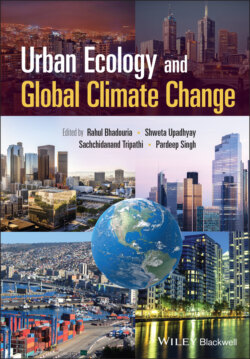Читать книгу Urban Ecology and Global Climate Change - Группа авторов - Страница 17
1.2.1 Urban (Built) Infrastructures
ОглавлениеUrban infrastructures are built to provide the services and benefits to the urban inhabitants (Ma et al. 2020). Urban habitats are almost similar over large areas or human‐managed cities and microclimatic regions (Savard et al. 2000) having a central square with paved areas, residential areas, urban parks, urban agriculture, and some disturbed/unmanaged plots (Lososová et al. 2018). Considerable impervious surfaces such as roofs, roads, and paving are the most common features of urban infrastructure which sets cities apart from adjacent rural areas (Vasishth 2015). Both the components (viz. natural and artificial) of urban infrastructure help in the maintenance of the ecosystem functioning and health (Kattel et al. 2013). For example, vegetation cover and water bodies in the urban and peri‐urban areas provide habitats for biological diversity and help in maintaining the integrity of the natural/ecological and physical environments (Hofmann et al. 2012). In addition to the natural and artificial classification, urban infrastructures can also be classified into two major components viz. aboveground and belowground (Ma et al. 2020). Aboveground component comprises of the infrastructures at/on which citizens live in, walk on and ride on, such as buildings, parking lots, roads, sidewalks, green spaces, and public transportation (Andersson et al. 2014). Belowground component encompasses massive foundations of the buildings, subway lines, tunnels, gas lines, water and sewage pipes, stormwater management, electricity, and optical cables for providing various services to the citizens and ease in their livelihood (Sun and Cui 2018; Ma et al. 2020). Both the components of the urban infrastructures hold crucial significance and interact with each other in complex ways (Pandit et al. 2015). Aboveground infrastructures provide living spaces and comforts to the citizens, whereas belowground components play equally important services in the form of utilities, transportation, biomass, and structures which enable the urban areas for smooth functioning of the aboveground components (Ferrer et al. 2018; Ma et al. 2020). Moreover, natural components of the urban infrastructures such as plant roots and microbial communities also show strong competition for the space in the belowground components (Mullaney et al. 2015).
Land‐use and land‐cover changes are one of the major drivers of global change processes which should be taken into account considerably from ecological point of view (Vitousek 1994). Urban land cover has been projected to increase by 200% within the first three decades (2000–2030) of the twenty‐first century (Elmqvist et al. 2013). These projections revealed that there has been and would be a massive investment in the development of the urban infrastructures at the cost of consumption of natural ecosystems/landscapes (Green et al. 2016). Increase in impervious surfaces and the materials used for their formation (dark asphalt and roofing materials) due to massive urbanisation have the ability to absorb the solar irradiance and influence the local climate and hydrological conditions (Vasishth 2015). UHI effect (described later) is one of the major outcomes of the increase in such urban built infrastructures (Jaganmohan et al. 2016). For managing the urban ecological components (e.g. biodiversity, nutrient cycling, etc.) influenced by the land‐use change patterns, several conceptual frameworks, and models have been developed (Pickett et al. 2011). However, their proper implementation is lacking due to poor representation of the social components in these frameworks (Zipperer et al. 2011). Nowadays landscape urbanism is the emerging concept with non‐hierarchical, flexible and strategic planning where landscapes in the urban areas are designed and managed as per the demand of the society (Kattel et al. 2013). Detailed elaboration of such strategies and frameworks has been given in the later sections of the chapter.
